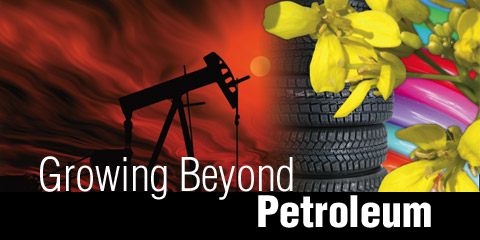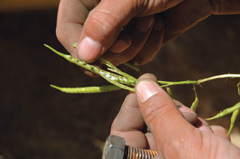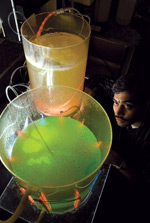Growing Beyond Petroleum

In 1941, Henry Ford created a car made almost entirely from plants. The car’s body was a mix of straw and flax held together with resins and soybean meal. Its tires were made from goldenrod latex; its fuel was made from vegetable oil. The car was stylish and lightweight and the plant-based plastic was so strong that when Ford swung at it with an ax, the ax bounced off.
Ford hoped his bio-based car would help drive the nation out of a 20-year economic depression that had forced so many American farmers off the land. But before the soybean car could go into production, the war was over and petrochemicals were transforming American industry and farms. Sixty-seven years later, some of Henry Ford’s ideas are being revisited in the new bio-economy. Researchers from Oregon State are exploring plant-based replacements for petroleum products in ways that sustain food production and protect the environment.
Fossil fuels were once plants, millions of years ago, so it makes sense that petroleum and plants share some basic molecular structure. There is practically nothing that can be made out of hydrocarbons that can’t be made out of carbohydrates.
 |
|
In 1941, Henry Ford (right) unveiled his carbohydrate car, a vehicle made almost entirely from plant-based plastics, rubber, and fiberglass. Photo from the collections of The Henry Ford; copy and reuse restrictions apply. |
Long before Henry Ford and his bio-based car, the nation’s economy was fueled by plants. Remnants of that era can be seen in tracks carved by wagons traveling the Oregon Trail, still visible on Kent Madison’s farm near Echo.
“When my grandfather worked this farm using horsepower, he set aside about 60 percent of the land for raising feed for horses,” Madison said, standing in a machine shed the size of a high school gym. “Now I’m running the farm using biodiesel, and I’ve set aside about 5 percent of the land for raising feedstock for biofuel.”
The machine shed is Madison’s refinery, his own biodiesel plant where he processes canola that he grows on his own farm. Prompted by high diesel costs and the low price of canola, he bought two crushing machines off the Internet a few years ago and began processing his own crop for oil. Today, the historic Oregon Trail that cuts through Madison’s farm passes a golden field of canola, part of a new bio-economy growing beyond petroleum.
 |
|
Canola’s oil is in its seed. At Madison Farms near Echo, canola harvest begins by cutting and pushing down the mustard-like plant to dry before threshing to recover the seed. Photos: Lynn Ketchum |
 |
There are still plenty of bumps in the road heading toward a bio-based economy. The U.S. government recently passed an energy bill to increase the use of biofuels, at the same time the United Nations called for a five-year moratorium on the use of food crops for fuel production. These diverging policies indicate a complex issue where politics, economics, and science intersect.
Much of the current bio-economy is focused on biofuel from feed corn and soybeans. In the American Midwest and elsewhere, those crops are fueling a boom in ethanol and biodiesel production and sparking a heated debate over food versus fuel. Although Oregon is not a corn-and-soybean powerhouse, it is home to two new commercial ethanol refineries, fueled in part by corn imported from the Midwest.
That’s where economics come into question, according to Bill Jaeger, an OSU economist who has studied various biofuel options for Oregon. Jaeger warns that simply being plant-based does not guarantee that a biofuel contributes less greenhouse gas to the atmosphere or improves energy independence compared to the petroleum it replaces. To be a viable substitute for fossil fuels, he says biofuels should produce more energy than is used to produce them. He emphasizes that the costs of production need to be figured into the equation, as well as the costs of potential side effects such as degrading the environment or reducing food supplies.
Most scientists agree that there is no silver-bullet solution, no one technology that will solve our dependence on foreign oil and lower greenhouse gas emissions. “The rush toward biofuel is a temporary measure until we can develop a more sustainable solution,” said Daryl Ehrensing, an OSU agronomist who explores new crops.
Despite the skyrocketing price of gasoline, fuel is still the least profitable product made from petroleum. Lubricants, plastics, and fabrics made from petrochemicals demand higher prices than gas. Similarly, gallon for gallon, biodiesel is the lowest-priced product made from vegetable oil, unless the oil is recycled after food processing or produced on the farm where it is used. Replacing high-value food with low-value biofuel makes no sense, economically or socially.
Oregon’s contribution to the world’s bio-economy will not be the same as Iowa’s. In Oregon, plant-based products will be more diverse than corn- and soy-based biofuel. Some new products may come from crops grown in rotation with high-value established crops such as wheat and grass seed. Some may be made from leftovers such as straw, wood pulp, or even municipal waste. And others may go back to the future, revisiting plant materials that preceded the petroleum-based economy. Some of these bio-products would be recognizable to Kent Madison’s grandfather; others are entirely new.
 |
|
OSU bioengineer Ganti Murthy examines bubbling cultures of algae in his lab where he is testing ways to extract useful oil from the likes of pond scum. Photo: Lynn Ketchum |
Take algae, for example. Algae are one of the world’s most plentiful oil-producing organisms, with thousands of known strains flourishing in fresh or salt waters from the arctic to the tropics. And although algae grow in water, they require 99 percent less water than crops such as corn or soybeans, according to Ganti Murthy, an OSU biological engineer. Murthy is studying ways to extract oils—called lipids—from algae and to process them into biodiesel fuel and ethanol.
Although commercialization of algal biofuel is still years away, the potential is huge. Murthy estimates that acre for acre, algae can produce 20 to 100 times more biodiesel than soybeans. And because algae can be grown in wastewater, they do not compete with food production. In fact, algae can grow in ponds next to coal-fired power plants, consuming carbon dioxide generated from fossil-fuel combustion.
Growing food crops year after year in one place can exhaust land and increase problems with pests and diseases. So researchers and farmers are looking for crops that can be grown in rotation with high-value food crops, rotation crops that can break the cycle of pests and disease, help enrich the soil, and offer opportunities for new bio-products.
“Not just any rotation crop will work,” says Don Wysocki, an OSU agronomist who has experimented with a variety of rotation crops for eastern Oregon wheat growers for more than a decade. “You have to ask: Will the crop grow here? Does it require special equipment or expensive inputs of fertilizer and water? Does it improve the land for growing food crops; and finally, is there a market for it?”
Since the 1990s, Wysocki has experimented with new varieties of canola as a rotation crop for wheat in the Columbia Basin. Canola fit as a rotation crop, although until recently marketing the oil meant shipping the seed to Canada for processing. But canola is sensitive to eastern Oregon cold. And, as a close relative to broccoli and other valuable seed crops, canola is strictly regulated in the warmer Willamette Valley to protect the purity of commercial vegetable seeds.
So, Wysocki is testing a new plant, one that is oblivious to cold and does not seem to interfere with the specialty seed market. It’s called camelina, and growers in Montana have been able to get reliable crops from seed scattered on top of snow-covered stubble fields. It requires little water or nitrogen and yields almost as much oil as canola, according to Wysocki.
Oil is not the only product made from these plants. “When you crush these seeds, you get a trickle of oil and a mountain of meal,” Ehrensing said. In the case of camelina, you get meal that is high in omega-3 oils and protein. OSU scientists are testing its use to enrich the diets and the eggs of laying hens.
A more familiar plant that is making a comeback in the bio-economy is flax. Before World War II, the Willamette Valley produced 95 percent of the nation’s flax, grown for either fiber (made into linen) or linseed oil (made into linoleum). Eventually flax products were replaced by petroleum-based fabrics (rayon and polyester) and plastic flooring.
 |
|
The fleshy roots of Russian dandelion ooze a stretchy, high-quality latex. Photo: Lynn Ketchum |
It turns out that flax is stronger than fiberglass and about one-third the weight. Henry Ford knew this. German car manufacturers know this, too; Mercedes and BMW currently use flax-based fiberglass in their dashboards, door panels, and headliners. And linoleum, made the old-fashioned way with flax-based linseed oil and filler, is showing up in modern green buildings as a more durable and non-toxic alternative to petroleum-based floorings.
The search for alternative sources of natural rubber goes back at least as far as Henry Ford’s goldenrod tires. Synthetic, petroleum-based rubber was a post-World-War-II innovation developed to free American dependence on natural rubber supplies in tropical South America and Malaysia. But the synthetic product proved inferior to natural rubber in radial tires and high-performance uses.
 |
|
OSU agronomist Daryl Ehrensing is leading the exploration of Russian dandelion as an alternative to synthetic petroleum-based rubber and to latex imported from tropical forests. Photo: Lynn Ketchum |
Ehrensing is exploring a source of high-quality latex from an unusual source: dandelions. Having read about Stalin-era experiments with dandelion rubber, Ehrensing obtained a few of the old seeds from vaults in the former Soviet Union. The seeds were dried up and worthless. So he and his collaborators arranged for a plant explorer to trek back to the source—the mountains of Kazakhstan—and collect a small handful of Russian dandelion seed. From those seeds, Ehrensing is selecting the heartiest plants with the highest content of latex, up to a quarter of the dry weight of their roots.
Moving beyond petroleum also means moving beyond waste. A sustainable bio-economy keeps organic matter out of the waste stream and cycled back as useful material. Such efforts seem almost literally to spin gold from straw. For example, Mike Penner, an OSU food chemist, is examining leftover grass seed straw and fruit pulp to find raw materials for making ethanol, specialty solvents, and other biochemicals to replace petrochemicals.
In addition, Penner is working with USDA plant physiologist Gary Banowetz to develop farm-scale technology to convert straw and other crop residue into energy right on the farm. “There is potential to produce 60 to 80 gallons of fuel from a ton of straw,” Banowetz said. “But there’s lots of variability. And we can’t take everything off the land to create fuel; we need to keep some residue on the fields to rebuild the soil.”
 |
|
OSU agronomist Don Wysocki leads a group of growers into a field of camelina during the Columbia Basin Agricultural Research Center’s Field Day. Photo: Lynn Ketchum |
It seems that every technological advance comes with a cautionary note about the potential for unintended consequences. The human population continues to grow; food and fuel prices are rising; the climate is changing. All this, plus economic progress in developing nations, put competing demands on food, energy, and a livable environment.
“Biofuels seem to promise massive solutions without changing our habits of consumption,” says Russ Karow, head of the crop and soil sciences department at OSU. “We want to drive the same, consume the same. If we want instant change, conservation may be our most reliable path. The minute we turn to biology for a solution, we increase uncertainty—unpredictable weather, pests, disease, and unpredictable consequences to the environment and society.”
Yet Karow sees opportunities for Oregon in a sustainable bio-economy. In particular, he sees the opportunity to produce seeds to grow new bio-products. There are few places in the world where seeds grow as well as here in Oregon, according to Karow, and OSU plant breeders are already working to develop the best new plant varieties for particular bio-products.
These new crops could grow a sustainable bio-economy that might take us even farther than Henry Ford’s soybean car.
Economics of Oilseed Crops and Their Biodiesel Potential in Oregon's Willamette Valley, Special Report 1081
Biofuel Potential in Oregon: Background and Evaluation of Options, Special Report 1078
